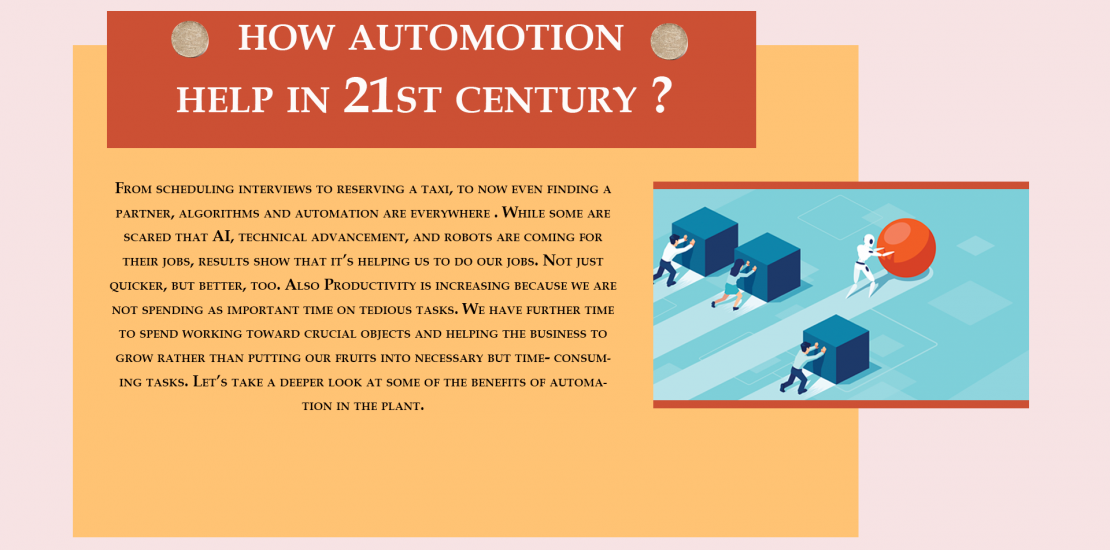- November 20, 2021
- Posted by: puser
- Category: AR / VR, Innovation, IoT technologies, Machine Learning, Robotics, Software Development

Automation Turing Our Lives In 21st Century
From scheduling interviews to reserving a taxi, to now even finding a partner, algorithms and automation are everywhere . While some are scared that AI, technical advancement, and robots are coming for their jobs, results show that it’s helping us to do our jobs. Not just quicker, but better, too. Also Productivity is increasing because we are not spending as important time on tedious tasks. We have further time to spend working toward crucial objects and helping the business to grow rather than putting our fruits into necessary but time- consuming tasks. Let’s take a deeper look at some of the benefits of automation in the plant.
Reduced time to Rehire
The longer a part remains open, the further businesses lose out not just from missing a hand, but from other workers filling in for that empty part, too. Reducing their time to fill is thus pivotal to reducing what can come a significant loss of productivity. Applicant shadowing systems and seeker relationship operation systems can help with nearly every step of the hiring process. It can shortlist campaigners briskly and more than a mortal; it can record interviews, and it can indeed conduct interviews. While this reduces the face time that campaigners get with reclamation brigades, it saves reclamation brigades hours every week. They can conduct in-person interviews more effectively because they’ve further time to prepare, meaning they ’re more likely to hire the right person first time.
Deducting Operational Charges
Every business faces global pressure to increase their profitability. One approach is to reduce costs. But, reducing the capabilities of the computer center negatively impacts the entire company.
Automated software is a better and further intelligent approach to cost constraint and deduction. The topmost occasion is to increase service to the client while totally reducing costs. Operation frequently overlooks this eventuality for savings. Most ultramodern waiters have a low operating cost and the total cost of power has been declining. Indeed so, the cost of the operations staff can be as high as 71% of the total cost.
Further Effective Hand Onboarding
It’s estimated that 20% of hand development happens during the first 45 days. An effective onboarding process is pivotal to reducing this figure. A further effective onboarding process also reduces how long an hand takes to reach full productivity, which is estimated to be between eight to 12 months. Organizations with a standard onboarding process experience 54% better productivity from new hires. A longer onboarding process also reduces how long it takes for new workers to reach full productivity by 50-75%. A standardized onboarding process also increases hand retention by 50%. Automation can help companies to ameliorate their onboarding process by creating automated workflows. These could include regular emails to help them through their first many weeks or when they pass a corner, or the automated scheduling of meetings with their colleagues. Onboarding apps can automatically tick off when tasks are complete and notify anyone involved that’s holding up the onboarding inflow. These overflows can be used for every new hire, with ways added or removed grounded on the new hire’s liabilities.
Labor Saving
Work automation can be particularly effective in sectors like manufacturing where workers carry out emphatic labor. Machines can help support workers, reduce physical strain by carrying out routine tasks and make them enjoy their work. Also they can do further professed work.
This isn’t to say that there’s not a big place for business upgradation in lower emphatic places. All processes, from hand onboarding to commercial spending requests, can be done by machines, letting workers spend their time more effectively and precisely . Businesses need to emphasize that this doesn’t mean workers are spare – rather that they will be demanded for further fulfilling and challenging tasks rather than some filling and building work.
To Sum Up All
Automation in the workplace has better results and benefits for everyone. It accelerates tedious tasks, improving candidates and employees’ experiences. This then improves revenue, productivity, and employer brand. It’s no longer a case of if businesses will embrace automation, but a case of victory. Businesses that fail to automate tasks risk not only losing the best candidates but also their best employees. We would like to raise a toast to the companies that are looking to the future and are more in tune with the needs of twenty-first century employees.
Leave a Reply
You must be logged in to post a comment.
